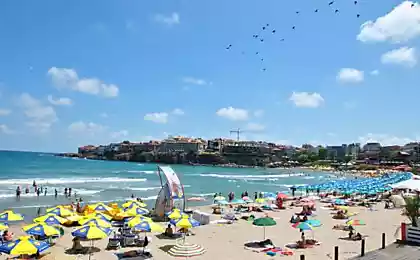978
On the territory of Bulgaria have been found the remains of two vampires

About the Bulgarian monastery on the Black Sea coast, near the town of Sozopol, local archaeologists announced that they had discovered two medieval skeleton "of vampires».
Dating back to 800 years of the Middle Ages, the skeletons were discovered during the excavations, with iron bars, which pierced their breasts - proof of exorcism, practiced against vampires. The ritual was aimed at preventing potentially dangerous "bad people", such as secret enemies of the Church, murderers or people suddenly died of a strange illness, in order to prevent them from turning into vampires after death.
"This practice was common in some Bulgarian villages up until the first decades of the 20th century," Bozhidar Dimitrov told reporters, director of the National History Museum in Sofia. Recently discovered the skeletons are the latest in a series of discoveries throughout Europe. According to Dimitrov, more than 100 skeletons buried in the same manner, were found during excavations only in Bulgaria itself.
Vampires that time were quite different from the aristocratic blood-sucking character depicted in the novel, horror, 1897 - "Dracula" and in countless Hollywood films.
In fact, the legend of the vampire was most likely generated by the appearance of large amounts of decaying bodies, which were the result of epidemics, violence in Europe between 1300 and 1700 AD. During these epidemics, mass graves are often re-excavated to bury new dead bodies, and gravediggers stumbled on the bodies that were bloated corpse gas.
With a ragged hole in the shroud used to cover their faces, these bodies shows people with still growing hair, teeth that came into pieces through the shroud, and blood seeping from their mouths.
In the days before the theory of microbial decomposition of the bodies and mechanisms have not been sufficiently studied, the corpses looked like whether they were still alive, they drank blood and gnaw their shrouds.
Modern forensic science would explain that shrouds destroy bacteria found in the mouth, but then it was thought that these "consumers shroud" were vampires, which spread black plague in Europe.
The wooden stake through the heart and stone, plugged into his mouth and killed "undead" creatures, while the iron rod that pierced his chest vampire attached the body to the ground, preventing that he rose from his grave and terrorized the people alive.
According to the archaeologist Petar Balabanov, who in 2004 found six skeletons nailed to the ground, around the Bulgarian town of Debelt, killing a vampire ritual was also distributed in neighboring Serbia and throughout the Balkans.























